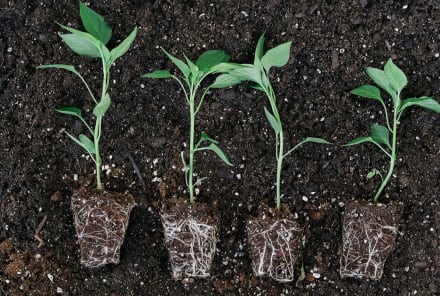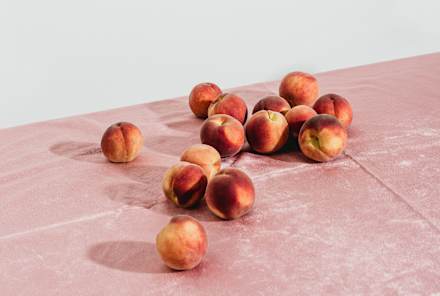Advertisement
The Research Is In: Yes, Gardening Totally Counts As Exercise

By this point, it's well understood that spending time in nature directly boosts physical and mental well-being. Gardening, therefore, is a super healthy habit. But just how healthy is it? Is spending an hour in your tulip bed the equivalent of spending it at the gym? Here's the latest research on how you can make sure your next gardening session serves as exercise for your body and mind.
Does gardening count as a workout?
Good news for those who already log hours planting and weeding: It's considered to be moderate exercise by the American Heart Association1, and you can easily burn the same number of calories2 gardening as you would at the gym. Digging, raking, and mowing are particularly effective3 at burning calories.
Beyond its caloric benefits, gardening can also help improve dexterity and strength2, muscle mass, aerobic endurance, and functional movement. Digging in the dirt can even help enhance bone density as one study by the University of Arkansas revealed. Out of 3,310 women aged 50 years old and older, those who gardened or did yard work at least once a week had higher bone density measurements than those who were sedentary or jogged, walked, or swam or did aerobics.
Gary L. Altman, M.S., CRC, HTR and associate director of the Horticultural Therapy Program at Rutgers University School of Environmental and Biological Sciences, explains that gardening incorporates all four types of exercise: endurance, strength, balance, and flexibility and can be much more vigorous than people may realize. "Gardening should be thought of as a whole-body exercise that works all of the major muscle groups including legs, buttocks, back, abdomen, neck, arms, and shoulders," he says.
Can it help you lose weight?
Melina Jampolis, M.D., physician nutrition specialist, says that gardening can indeed aid with weight loss, citing a study4 that looked at the link between community gardening and nutrition and physical health among adults. In the end, gardening appeared to have a significantly positive effect on BMI reduction. "I think the mental health and stress-related benefits that gardening provides coupled with the fact that it keeps you out of the kitchen or TV room, where boredom eating often happens, can help with weight loss as well," Jampolis adds.
Another study, conducted by the University of Utah, found that people who participated in community gardening had not only a substantially lower body mass index but also lower odds of being overweight or obese than the nongardeners. Women community gardeners weighed on average 11 pounds less than nongardeners, and men weighed 16 pounds less.
Ann Kulze, M.D., wellness expert and author, also notes that gardening can encourage you to eat more greens! When you grow your own vegetables, fruits, or herbs, you are constantly reminded of how tasty fresh, nutritious produce can be.
5 ways to make your gardening more vigorous.
Jeffrey Restuccio, author of two books on how to transform gardening into a comprehensive fitness program, notes that there are things you must keep in mind when it comes to approaching gardening as a physical activity. "Gardening, the wrong way, as exercise can cause muscle soreness, back pain and is inefficient and not effective as an exercise program," he says. In Aerobic Gardening, Restuccio highlights numerous ways people can indeed make gardening more of an effective way to get moving. "Every addition increases the calories burned, exercise benefits, and reduces muscle soreness and potential for injury," he says. Here are a few of his favorite ideas for making gardening more vigorous:
1. Increase your range of motion.
This is an important technique borrowed from martial arts as well as weight training. Essentially, you'll want to increase your "range of motion" as wide as possible when raking or hand-weeding by increasing the sweep or arc from your starting position to your ending position. "At first, this will take some continuous effort and practice, but it will increase the stretch, caloric expenditures, and the muscles used," notes Restuccio.
2. Learn the "lunge and weed."
Restuccio says he came up with the lunge-and-weed stance idea after observing people at the gym lunging forward with one leg bent while holding dumbbells with both hands. To do this stance, you want to rest your left arm on your left knee when weeding with your right hand. Alternate this motion if you're left-handed. A tool with a long handle is essential for this one, as you need to be able to dig in the dirt from a crouching position with your knee bent and back muscles straight. Restuccio says that performing gardening tasks in this stance for 30 to 40 minutes can be roughly equivalent to walking or riding a bike in terms of calories burned.
3. Use large muscles whenever possible.
Always strive to engage your largest muscles (think quadriceps, buttocks, and torso) when gardening. Transferring the effort from the small muscles of your arms and lower back to the large muscles of your legs and buttocks will help you burn more calories and feel less sore the next day.
4. Remember to balance everything out.
As you garden, pull one arm in as the other moves out, like you would if you were curling dumbbells. This technique can help balance the muscles used, increase your power, and raise your heart rate into the aerobic training zone.
5. If you want to really commit, think of gardening in terms of repetitions and sets.
While raking and digging a hole aren't the same as doing a leg press, the concepts are pretty similar. Restuccio suggests grouping raking and cultivating motions first into repetitions and then sets. For example, raking 10 to 15 sweeps briskly can be one set. Rest or continue doing something else for a minute, then continue raking. This type of thinking is most effective for difficult activities like picking up bags of soil, digging, raking, or turning a compost pile.
Bonus: Gardening can boost your mental health, too.
Beyond the physical benefits, there are a number of mental perks associated with gardening and working with plants, too. For starters, since gardening usually requires some time under the sun, Altman reminds us that it can increase your vitamin D intake. Vitamin D not only serves as a mood booster, but it's also an important nutrient for every single organ system including our bones5, brain6, heart6, kidneys6, and immune system6.
He also notes that surrounding yourself with plants "creates a sanctuary for us to feel safe and calm," leading to feelings of relaxation and comfort7. One 2010 study8 revealed that 30 minutes of gardening decreased more stress than 30 minutes of indoor reading. Mycobacterium vaccae, a bacterium in soil, has even been found to trigger the release of serotonin, which, in turn, improves mood and decreases anxiety.
Community gardens, in particular, can help decrease feelings of isolation3 and boost self-esteem9 as they enable people to get together socially and be a part of a project. (If you're interested in finding out where your nearest community garden is, check out the locator tool on the American Community Gardening Association's website.)
The act of gardening, whether on a small scale or a larger one, requires a multistep thinking process. As a result, as Amy Wagenfeld, Ph.D., OTR/L, SCEM, FAOTA, associate professor in the occupational therapy doctorate program at Johnson & Wales University, points out, studies have shown that the activity can help to improve cognitive function10, including the ability to concentrate11.
It has also been reported that the benefits of gardening projects can delay the symptoms of dementia. George Papanicolaou, D.O., functional medicine doctor at Mark Hyman’s UltraWellness Center, references one study12 in particular, which followed nearly 3,000 older adults for 16 years, tracking incidents of all kinds of dementia and assessing a variety of lifestyle factors. He notes that the researchers found daily gardening to represent the single biggest risk reduction for dementia, reducing incidence by 36%.
Papanicolaou adds that young minds can reap huge benefits as well. "School-based gardens are popping up all over the place, and there is good reason why—studies have found that gardening resulted in improvement in learning and a significant increase in achievement test scoring," he says.
The next time you're feeling lethargic, overwhelmed, or just in need of a quick sweat fix, try getting a little dirt under those nails, and see what happens.
12 Sources
- https://www.heart.org/en/healthy-living/fitness/fitness-basics/aha-recs-for-physical-activity-in-adults
- https://www.ncbi.nlm.nih.gov/pmc/articles/PMC6334070/
- https://www.ncbi.nlm.nih.gov/pmc/articles/PMC6334070/#R42
- https://www.ncbi.nlm.nih.gov/pubmed/30982073
- https://www.ncbi.nlm.nih.gov/pubmed/24491882
- https://www.ncbi.nlm.nih.gov/pubmed/16174483
- https://www.ncbi.nlm.nih.gov/pmc/articles/PMC3974224/
- https://journals.sagepub.com/doi/abs/10.1177/1359105310365577
- https://journals.sagepub.com/doi/abs/10.1177/0042085907304909?journalCode=uexa
- https://www.ncbi.nlm.nih.gov/pmc/articles/PMC6427672/
- https://www.tandfonline.com/doi/abs/10.3109/11038128.2015.1085596
- https://www.ncbi.nlm.nih.gov/pubmed/16411871











